What’s New
SAINT VALENTINE

Saint Valentine’s bird companion would, of course, be exquisite. While I was building this picture, I walked into a garden center looking for a new tree and BAM! There was the white peacock. I returned with my good camera and followed him around for an afternoon, taking hundreds of photos.
Saint Valentine and the peacock have bound themselves with a single satin ribbon and a locket. I wrote the word “Devotion” on a note card and kept it beside me while I worked. The curtains curve around the peacock and young man to frame them and seclude them.
Tokens of their fondness for each other are strewn on the table. Shared snacks, love letters, a key with a filigree heart on the end. The porcelain heart box with the gold peacock on the lid is from 1761. It’s in the Metropolitan Museum of Art. “Mazarine Blue” was often used by The Chelsea Porcelain Factory as a ground color at the time. The other objects are from Dutch Still Life paintings in the early 1600’s. For example, the cherries are from “Basket of Flowers”, 1622 by Balthasar van der Ast.
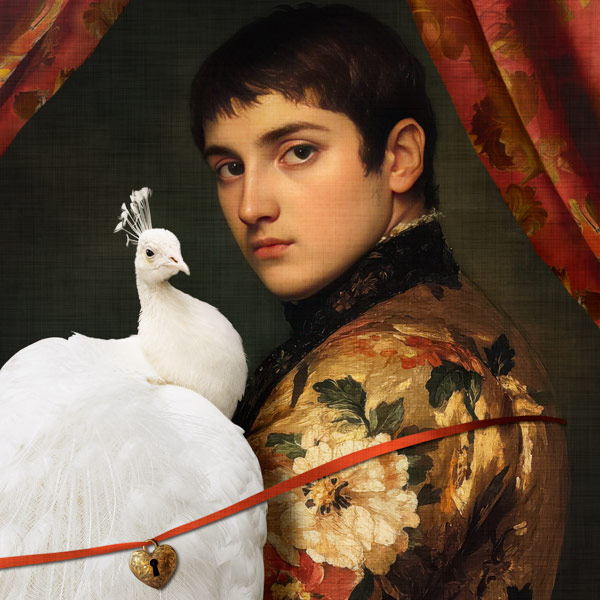
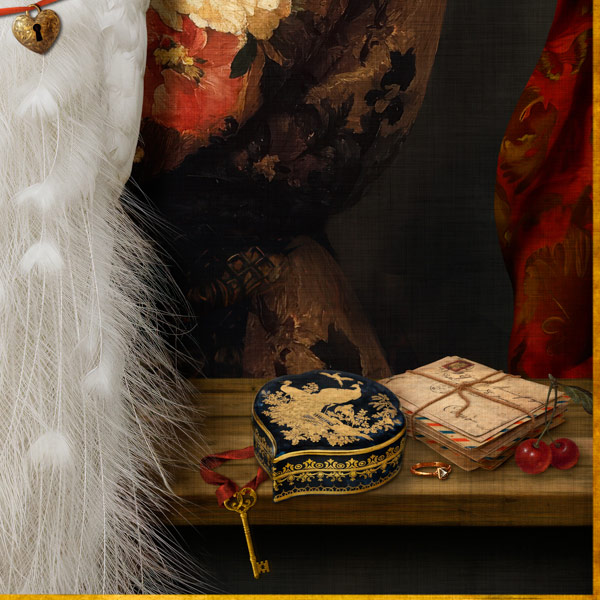
A MORE RATIONAL DAY THAN THE LAST

Things are looking up. The wind is in your hair. You’ve hitched a ride on a leviathan, off to somewhere delightful and completely unknown. You lean into the wind.
The cloud is the perfect cloud, the essence of cloud. Fortunately, I had my camera in my hands when I looked up and saw it. I photographed it and it was gone in a breath. It has mystery. It has gravitas. It has enough presence to hold its own, even in a picture with a whale.
I’ve never seen a blue whale. I’ve never seen a FLYING blue whale. I called this one up from my imagination, but it took a lot of thinking.
Bon voyage.
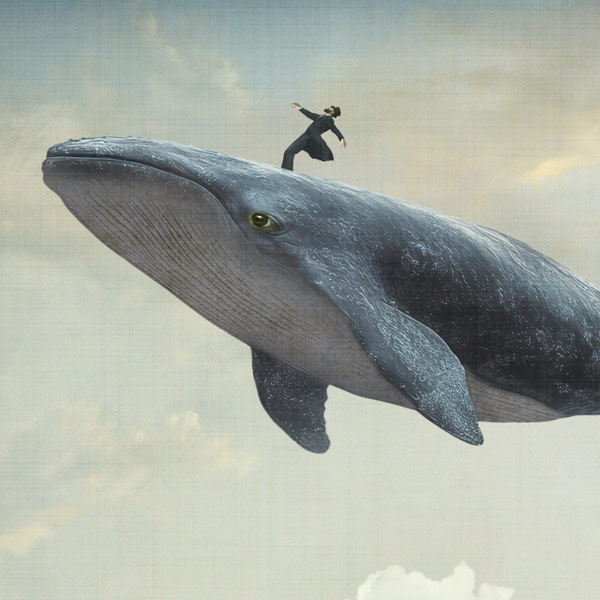

HIGH TEA

Chaos, tumult, havoc. Bighorn sheep have done a number on this room. And there goes the cake….
The room and its panels are a riff on the Metropolitan Museum of Art’s exquisite turquoise room, the Boiserie from the Palais Paar (constructed in Vienna 1765-72).
The teapot is really yellow and came down through my husband’s family. The teacup – in our family it’s the most prized teacup, because of its absolutely perfect fracture. I photographed the cracks on stucco buildings. We stop abruptly for good cracks.
The hostess is clutching her guest, trying to remain serene. We can see in the rabbit’s eye that he may not be a willing partygoer.
While I was working on this picture, I was struck by how Bighorn sheep have a decadent Rococo beauty all their own. They can jump fifteen feet, more if they spring off a sofa.
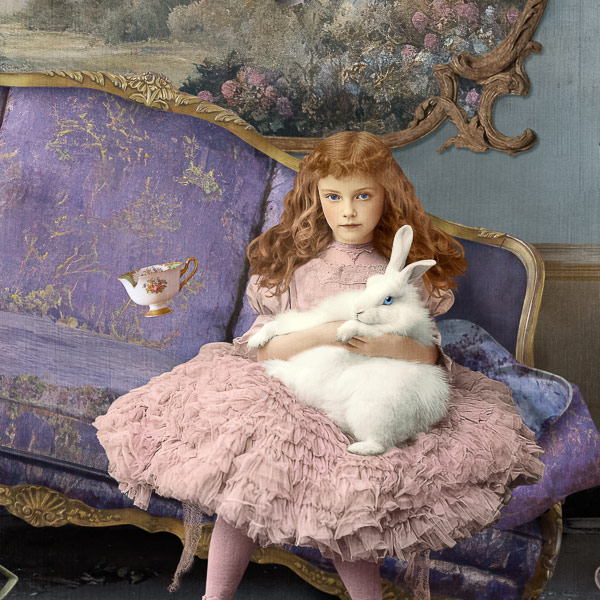
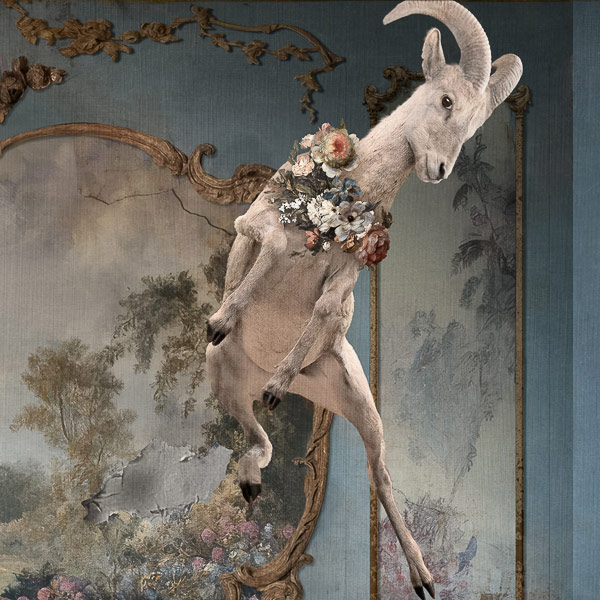
WILD ABOUT YOU

I made “Wild About You” in the month before a wedding in the family. Here, the newlyweds invite a few friends to celebrate on their honeymoon cruise. Also chocolate.
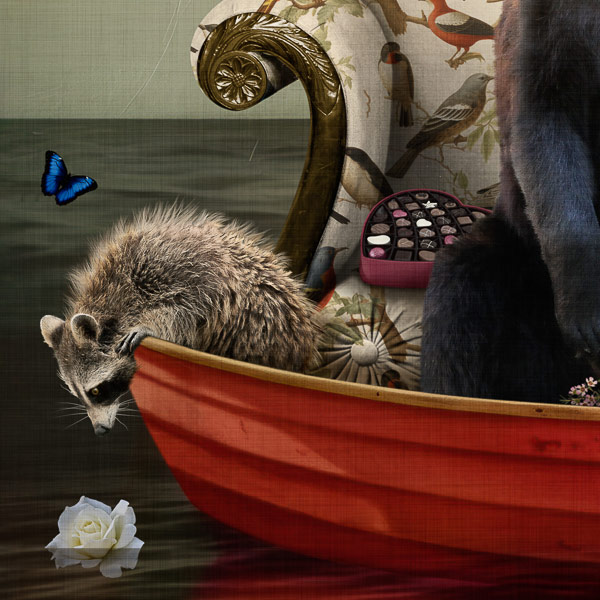
THERE GOETH THE NEIGHBORHOOD

We’re familiar with the Adam and Eve story. Here’s their arrival, as seen by the Garden dwellers. Eden may never be the same. The animals have their doubts.
I made the dome of the flying saucer from a photo I took of the Marble Church in Copenhagen when I lived there. Best Souvenir ever!
I made some of the animals from my own photos. Others are from Johann Peter Wenzel’s 1800-1829 painting “Adam and Eve in the Garden of Eden” and from Melchior d’Hondecoeter’s 1600-1692 painting “Landscape with Exotic Animals”.
Adam and Eve are from Adriaen van der Werff’s 1717 painting “God hold Adam and Eve Responsible”.
The Background is a reimagined version of Fragonard’s “Le Rocher” 1780.
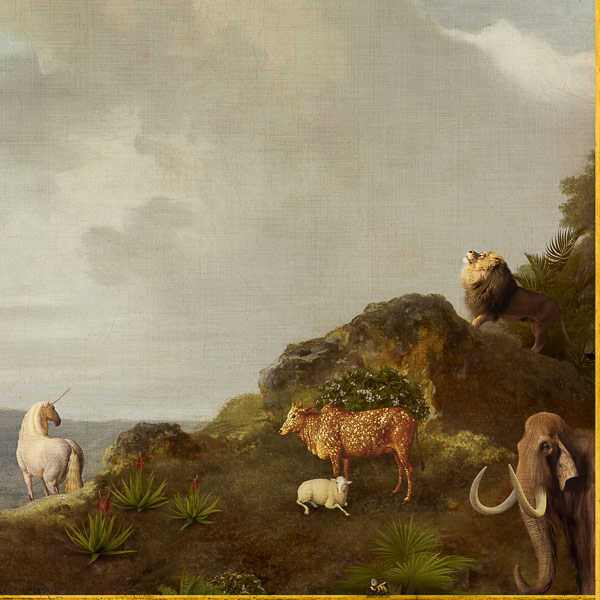
We’re familiar with the Adam and Eve story. Here’s their arrival, as seen by the Garden dwellers. Eden may never be the same. The animals have their doubts.
I made the dome of the flying saucer from a photo I took of the Marble Church in Copenhagen when I lived there. Best Souvenir ever!
I made some of the animals from my own photos. Others are from Johann Peter Wenzel’s 1800-1829 painting “Adam and Eve in the Garden of Eden” and from Melchior d’Hondecoeter’s 1600-1692 painting “Landscape with Exotic Animals”.
Adam and Eve are from Adriaen van der Werff’s 1717 painting “God hold Adam and Eve Responsible”.
The Background is a reimagined version of Fragonard’s “Le Rocher” 1780.
WALKIES

If dogs had mythology, this would be their goddess – the woman with the leash and the ball. I wrote down the word “Glorious” and kept it near while I worked.
The goddess figure is a Diana. A huntress is what dogs are looking for in a goddess.
This work follows stylized French court portraits of the 18th century. The Goddess is from a Portrait of Madame Bonnier de la Mosson as Diana by Nattier.
Keep your eye on the ball.
